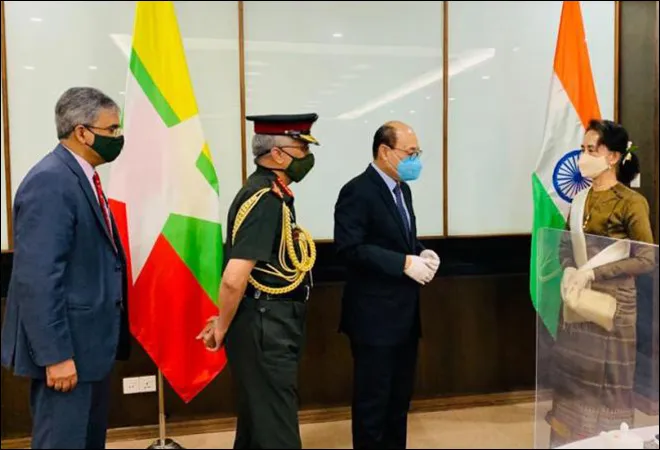The recent visit of Foreign Secretary Harsh Vardhan Shringla and Chief of the Army Staff Gen. Manoj Naravane to Myanmar reflected India’s multidimensional interests in the country and the deepening of ties between Delhi and Naypyidaw. Coming a few weeks before Myanmar’s general election, the visit underscored two lines of thinking that drive India’s Myanmar policy: engagement with key political actors and balancing neighbours. For Myanmar, the visit would be viewed as India’s support for its efforts in strengthening democratisation amidst criticisms by rights groups over the credibility of its upcoming election. The Indian delegation met State Counsellor Aung San Suu Kyi and Myanmar’s military Commander-in-Chief Senior General Min Aung Hlaing.
Non-interference in internal politics
The political logic that has shaped India’s Myanmar policy since the 1990s has been to support democratisation driven from within the country. This has allowed Delhi to engage with the military that played a key role in Myanmar’s political transition and is still an important political actor. It has also enabled Delhi to work with the party in power, whether the military-backed Union Solidarity and Development Party that won the 2010 polls or the pro-democracy National League for Democracy, which is in power now.
India is cognisant of the geopolitical dimension of Myanmar’s democratisation. Myanmar’s political transition created challenges for Naypyidaw and limited its ties with the West. India and a few Asian countries have engaged Myanmar keeping in mind the need to reintegrate it with the region and world. This has been a strategic imperative for Naypyidaw as part of its policy of diversifying its foreign engagements.
A key factor behind the military regime’s decision to open the country when it initiated reforms was, in part, to reduce dependence on China. By engaging Myanmar, Delhi provides alternative options to Naypyidaw. This driver in India’s Myanmar policy has perhaps gained greater salience in the rapidly changing regional geopolitics.
Recent initiatives
Like in other neighbouring countries, India suffers from an image of being unable get its act together in making its presence felt on the ground. Some initiatives announced during the joint visit suggest Delhi is taking steps to leverage its political, diplomatic, and security ties with Myanmar to address some of these issues. The inauguration of the liaison office of the Embassy of India in Naypyidaw may seem a routine diplomatic activity. However, establishing a permanent presence in the capital where only a few countries have set up such offices does matter. Interestingly, China was the first country to establish a liaison office in Naypyidaw in 2017.
India has also proposed to build a petroleum refinery in Myanmar that would involve an investment of $6 billion. This is another indication of Myanmar’s growing significance in India’s strategic calculus, particularly in energy security. It also shows India’s evolving competitive dynamic with China in the sector at a time when tensions between the two have intensified.
Another area of cooperation that has expanded involves the border areas. The joint visit reiterated the “mutual commitment not to allow respective territories to be used for activities inimical to each other.” Both Delhi and Naypyidaw have been collaborating in the development of border areas with the understanding that it is the best guarantee to secure their borders. And this is an area where the fruits of bilateral cooperation are already evident on the ground. Furthermore, the recent announcement that India was transferring a Kilo-class submarine to Myanmar demonstrates the depth of their cooperation in the maritime domain.
Last, for Delhi, the balancing act between Bangladesh and Myanmar remains one of the keys to its overall approach to the Rohingya issue. Delhi has reiterated its support for “ensuring safe, sustainable and speedy return of displaced persons” to Myanmar. The choices before Delhi are limited on the issue. By positioning as playing an active role in facilitating the return of Rohingya refugees to Myanmar, India has made it clear that it supports Myanmar’s efforts and also understands Bangladesh’s burden. For Delhi, engaging rather than criticising is the most practical approach to finding a solution.
Delhi’s political engagement and diplomatic balancing seems to have worked so far in its ties with Myanmar. Whether it has leveraged these advantages on the ground to the full is open to debate. The aforementioned initiatives could be the beginning of change on the ground by establishing India’s presence in sectors where it ought to be more pronounced. For India, Myanmar is key in linking South Asia to Southeast Asia and the eastern periphery becomes the focal point for New Delhi’s regional outreach.
This commentary originally appeared in The Hindu
The views expressed above belong to the author(s). ORF research and analyses now available on Telegram! Click here to access our curated content — blogs, longforms and interviews.




 PREV
PREV



